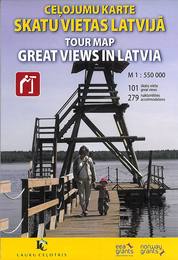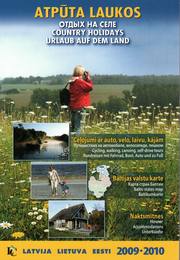Publications
Publications of "Lauku ceļotājs"
Our publications in English: accommodation catalogue „Country Holidays”, maps and travel guides for touring Latvia by car, bike, boating or hiking offer practical information and are most useful to plan and experience your holidays in Latvia. We have inspected all sites and tested all routes which are described. See below the details about contents of each of our publications.
To order the publications please send a request to the e-mail: lauku@celotajs.lv. You can pay for the publication with credit card or bank transfer. To read regular news about our new publications, please follow this link.
| Publication | Description |
|---|---|
Great Views in LatviaThe new map includes 101 great views' sites in Latvia created by nature or people - viewing towers, hills, riverbanks from where travellers can enjoy the landscapes of Latvia in different seasons. For each site, there is a description, a photo and contact details to book excursions or other services, where provided. Tourist accommodations provided by the Latvian Country Tourism Association are also included. The map is available from the office of "Lauku ceļotājs", and as a free supplement to the catalogue "Country Holidays 2009-2010". The map is produced under the project ""Sustainable use and management of nature resources in the Natura2000 sites - popular and potential tourism destinations in Latvia." |
|
Country Holidays 2009-2010The catalogue features 366 vacation sites in Latvia, Lithuania and Estonia: B&B, self-catering cottages and apartments, guesthouses, hotels, castles, manor houses and campsites with colour photos, full descriptions and contact information. The catalogue offers sections with hotels and guesthouses in the Baltic capitals Riga, Vilnius and Tallinn and self-drive tours and cycling tours in Latvia, Lithuania, Estonia. This year we started a new section with open farms (animal breeding, crop, food production, etc.), craftsmen, and other, offering guests to observe their production processes, try one's hand at crafts, taste and buy fresh local produce. A Baltic states map is enclosed to the catalogue where all the accommodations are marked with special symbols. Languages: English, German, Latvian, Russian |
|



